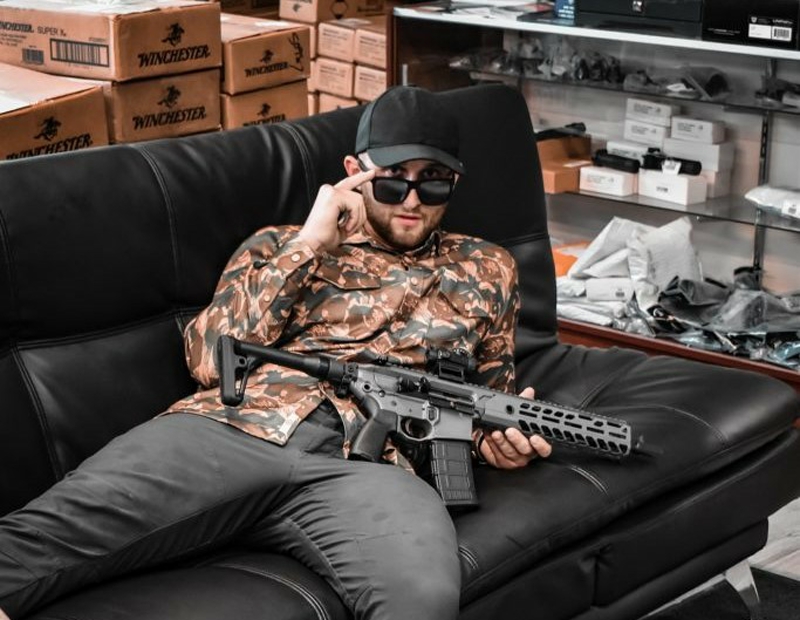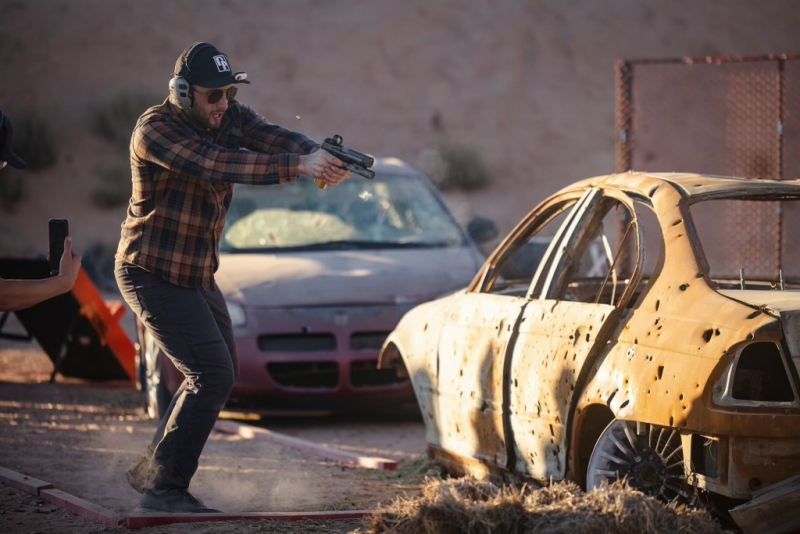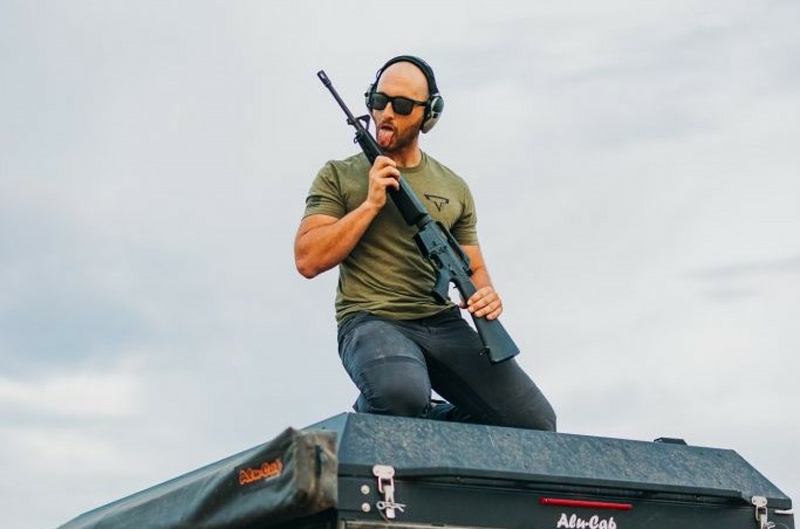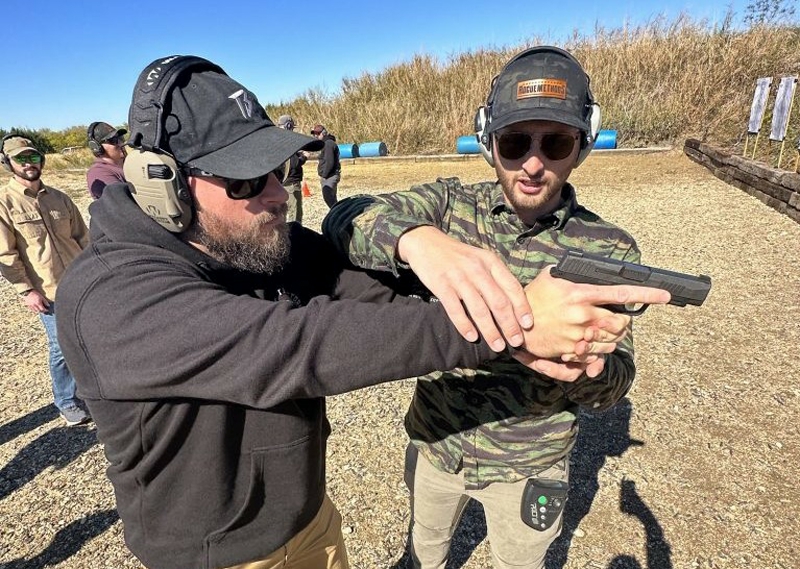Gå offline med appen Player FM !
202 — Hunter Constantine’s Baptism by Fire
Manage episode 347888933 series 1539957
GunMag Warehouse’s Jeremy Stone is back with another interesting and insightful podcast. This month, Jeremy sits down with USPSA Grandmaster Hunter Constantine right before shooting his own very first match. They discuss Hunter’s meteoric rise in the sport and what it takes to develop and maintain good shooting skills.

Jeremy starts by saying that his podcast guests are “people that I dig. People that I see on social media doing cool [stuff] and that I can learn from…I’m on a journey of getting better at shooting guns.” Hunter stood out to him because he does some funny stuff but he’s also a very high-level competitor.
A Relatively Late Start
Hunter recounts how he never fired a gun until he was 18. His uncle took him to the range and handed him a 1911 with factory 230-grain ball ammo. He laughingly says it was “as much recoil as I could probably ask for.” “After that weekend,” he adds, “I just fell in love with it.”
Hunter bought his first firearms shortly thereafter and began shooting recreationally. After moving to Tucson, Arizona, he looked into competition shooting. He had been a high-level bicycle rider but knew he could only focus on one thing if he wanted to perform well. He chose shooting because he thought it was “badass and cool.” No argument here.
Jumping in With Both Feet
So, at age 24, Hunter Googled “how to shoot competition.” The results returned a local pistol club, so he called the match director, who told him “To just show up.” The first few months, Hunter was dead last in the local standings. But he was enjoying himself and stayed with it.
Hunter says he especially enjoys the social aspect of competitive shooting. Most of his friends are in the firearms community. Jeremy echoes that sentiment. He says the online gun community is “vastly different” from in-person interactions. He notes that there is a world of difference between “the comment section” and how humble and inclusive gun people are in real life.
“They want you to come out and shoot,” Jeremy says, “they want to grow the sport, they want to get more people involved.” Hunter agrees, saying that was his exact experience. He didn’t know the rules or the gear, but people were glad he was there. They gave him tips on gear and even loaned him items to try out for himself. He used that experience to develop his own setup and he now rocks his EDC rig during matches. He says competitive shooting is “open arms for everybody involved.”

“I encourage people to go to the match and shoot with whatever gear you have. You don’t have to spend thousands of dollars on a new gun and a new belt. Just go shoot with what you have. People will welcome you.” He says that maybe you shouldn’t go shoot at the nationals with the wrong gear, but local matches will teach you what you need and what you don’t.
Hunter then details how he did not do that and how those lessons were learned. He started with a straight-up Gucci setup and that was a mistake. He now shoots a Smith & Wesson and loves it. Hunter then discusses his daily training routine and shooting schedule. Jeremy says early on that Hunter’s cold start drills are what drew his attention.
Fast Tracking to Pro Shooter
Hunter decided to pursue USPSA as his discipline, but right as he made that decision, the USPSA directors at his club stepped down. No one else was interested, so Hunter volunteered. He became the match director before he even had his USPSA membership.
He learned on the job by putting on matches for world-class shooters. No pressure there. That was his “Baptism by fire,” so to speak. It obviously worked out well. Hunter kept up his training, too. “There’s no parties, no chasing girls,” he says. It took disciplined and diligent work.
When he picked up his first sponsor, Hunter gave his commercial real estate company 2 months’ notice. He used his severance pay to buy gear and 28,000 rounds of ammo. He thought it would last a year. Those 28,000 rounds were gone in 3 months. But those 3 months also saw him rise from a high B-class shooter to Grand Master status.

Jeremy notes that the foundations for that improvement aren’t seen on social media. “It’s not real sexy to show work happening, and the sacrifice as well.” Hunter agrees. Hobbies and other activities just fell away while he pursued that goal.
Maintaining and Growing Skills
Hunter says that shooting major competitions is most beneficial to him now. Being around a nationwide talent pool makes him better. He sees how they shoot, giving him the opportunity to emulate their techniques and habits. He also says that seeing them in person is much better than watching them on video or social media. Watching in real-time is better suited to detailed analysis of what they are doing.
Plus, actually competing against those shooters is more beneficial than just practicing. The competition drives you to be better and brings out any weaknesses in your technique and mindset. Jeremy adds that, as he gets into competitive shooting, he wants to make sure his range time is building toward something. Hunter concurs, saying that “there’s a difference between shooting and practicing.”
Hunter has reached the point where he is working on his brain’s processing power. He can analyze his technique as he performs full-speed drills. That translates to competition, making him better. Being able to mentally break down techniques in real-time slows everything down in his mind, almost like slow motion.
Hunter focuses on technique over raw speed. Good technique allows him to be faster, but he tries to balance speed and accuracy. He makes it about repeatable performance, which improves over time, leading to long-term success. Consistency is key. It’s much better than high and low spikes. Knowing you can reproduce a given performance level at any time is a powerful tool.

Make it Fun
Shooting is and can be a lifelong sport. But only if it’s fun. “If you’re not having fun, Hunter says, “it’s not for you.” He admits that some shooters approach it differently, but even during matches, he tries to have fun, whether it’s joking around with the range officers, or whatever. The relaxed, fun mindset helps him shoot better and certainly makes shooting professionally sustainable.
Hunter carries that mindset into training as well. The classes he teaches are relaxed, which he believes helps his students. He says he’s never cared for the “drill instructor” style of training that is so prevalent right now. He believes students get more from a class “where it feels like we’re all just hanging out.” Jeremy says he thinks there’s a place for both, depending on each person, to which Hunter agrees.
A good discussion about a winning mindset and mental preparation follows. I won’t try to recapture that here because you’ll want to hear it for yourself, just like the rest of the stuff I left out.
Finishing Up
Hunter and Jeremy talk about how beginners may be reluctant to get involved because they don’t want to be at the bottom of the standings at first. Hunter understands because he’s been there. But sticking it out and putting the work in pays off in shooting, just as it does everywhere else. Hunter says he feels great satisfaction when he sees former students moving up the standings.

Despite his success, Hunter still sees himself as a student. He’s always learning new things to make him better. One thing he learned was that cycling through different guns and gear doesn’t help. Once you find what works, focus on that. You get good when you settle on one gun.
Hunter estimates he has 150-200,000 rounds through his chosen Smith & Wesson platform. He’s shooting for a million. “That allows me to understand that gun inside and out. I know what recoil feels like when it’s a light round. I know when it’s a bad grip…I can call my shot based on how that gun feels in my hand.” Powerful stuff.
Hunter’s gear experiments led him to develop and market his own gun belt, which he proudly says is all made in the USA, from start to finish. He says, “it’s the most comfortable belt you could possibly wear.” He tells you where you can find one if you’re interested. He also talks about the courses he offers and where you can access that training.
All in all, this is a very interesting and informative podcast. Do yourself a favor and listen to it. You’ll learn something.
https://media.blubrry.com/gunfightercast/content.blubrry.com/gunfightercast/Hunter_podcast_audio_only.mp3
60 episoder
Manage episode 347888933 series 1539957
GunMag Warehouse’s Jeremy Stone is back with another interesting and insightful podcast. This month, Jeremy sits down with USPSA Grandmaster Hunter Constantine right before shooting his own very first match. They discuss Hunter’s meteoric rise in the sport and what it takes to develop and maintain good shooting skills.

Jeremy starts by saying that his podcast guests are “people that I dig. People that I see on social media doing cool [stuff] and that I can learn from…I’m on a journey of getting better at shooting guns.” Hunter stood out to him because he does some funny stuff but he’s also a very high-level competitor.
A Relatively Late Start
Hunter recounts how he never fired a gun until he was 18. His uncle took him to the range and handed him a 1911 with factory 230-grain ball ammo. He laughingly says it was “as much recoil as I could probably ask for.” “After that weekend,” he adds, “I just fell in love with it.”
Hunter bought his first firearms shortly thereafter and began shooting recreationally. After moving to Tucson, Arizona, he looked into competition shooting. He had been a high-level bicycle rider but knew he could only focus on one thing if he wanted to perform well. He chose shooting because he thought it was “badass and cool.” No argument here.
Jumping in With Both Feet
So, at age 24, Hunter Googled “how to shoot competition.” The results returned a local pistol club, so he called the match director, who told him “To just show up.” The first few months, Hunter was dead last in the local standings. But he was enjoying himself and stayed with it.
Hunter says he especially enjoys the social aspect of competitive shooting. Most of his friends are in the firearms community. Jeremy echoes that sentiment. He says the online gun community is “vastly different” from in-person interactions. He notes that there is a world of difference between “the comment section” and how humble and inclusive gun people are in real life.
“They want you to come out and shoot,” Jeremy says, “they want to grow the sport, they want to get more people involved.” Hunter agrees, saying that was his exact experience. He didn’t know the rules or the gear, but people were glad he was there. They gave him tips on gear and even loaned him items to try out for himself. He used that experience to develop his own setup and he now rocks his EDC rig during matches. He says competitive shooting is “open arms for everybody involved.”

“I encourage people to go to the match and shoot with whatever gear you have. You don’t have to spend thousands of dollars on a new gun and a new belt. Just go shoot with what you have. People will welcome you.” He says that maybe you shouldn’t go shoot at the nationals with the wrong gear, but local matches will teach you what you need and what you don’t.
Hunter then details how he did not do that and how those lessons were learned. He started with a straight-up Gucci setup and that was a mistake. He now shoots a Smith & Wesson and loves it. Hunter then discusses his daily training routine and shooting schedule. Jeremy says early on that Hunter’s cold start drills are what drew his attention.
Fast Tracking to Pro Shooter
Hunter decided to pursue USPSA as his discipline, but right as he made that decision, the USPSA directors at his club stepped down. No one else was interested, so Hunter volunteered. He became the match director before he even had his USPSA membership.
He learned on the job by putting on matches for world-class shooters. No pressure there. That was his “Baptism by fire,” so to speak. It obviously worked out well. Hunter kept up his training, too. “There’s no parties, no chasing girls,” he says. It took disciplined and diligent work.
When he picked up his first sponsor, Hunter gave his commercial real estate company 2 months’ notice. He used his severance pay to buy gear and 28,000 rounds of ammo. He thought it would last a year. Those 28,000 rounds were gone in 3 months. But those 3 months also saw him rise from a high B-class shooter to Grand Master status.

Jeremy notes that the foundations for that improvement aren’t seen on social media. “It’s not real sexy to show work happening, and the sacrifice as well.” Hunter agrees. Hobbies and other activities just fell away while he pursued that goal.
Maintaining and Growing Skills
Hunter says that shooting major competitions is most beneficial to him now. Being around a nationwide talent pool makes him better. He sees how they shoot, giving him the opportunity to emulate their techniques and habits. He also says that seeing them in person is much better than watching them on video or social media. Watching in real-time is better suited to detailed analysis of what they are doing.
Plus, actually competing against those shooters is more beneficial than just practicing. The competition drives you to be better and brings out any weaknesses in your technique and mindset. Jeremy adds that, as he gets into competitive shooting, he wants to make sure his range time is building toward something. Hunter concurs, saying that “there’s a difference between shooting and practicing.”
Hunter has reached the point where he is working on his brain’s processing power. He can analyze his technique as he performs full-speed drills. That translates to competition, making him better. Being able to mentally break down techniques in real-time slows everything down in his mind, almost like slow motion.
Hunter focuses on technique over raw speed. Good technique allows him to be faster, but he tries to balance speed and accuracy. He makes it about repeatable performance, which improves over time, leading to long-term success. Consistency is key. It’s much better than high and low spikes. Knowing you can reproduce a given performance level at any time is a powerful tool.

Make it Fun
Shooting is and can be a lifelong sport. But only if it’s fun. “If you’re not having fun, Hunter says, “it’s not for you.” He admits that some shooters approach it differently, but even during matches, he tries to have fun, whether it’s joking around with the range officers, or whatever. The relaxed, fun mindset helps him shoot better and certainly makes shooting professionally sustainable.
Hunter carries that mindset into training as well. The classes he teaches are relaxed, which he believes helps his students. He says he’s never cared for the “drill instructor” style of training that is so prevalent right now. He believes students get more from a class “where it feels like we’re all just hanging out.” Jeremy says he thinks there’s a place for both, depending on each person, to which Hunter agrees.
A good discussion about a winning mindset and mental preparation follows. I won’t try to recapture that here because you’ll want to hear it for yourself, just like the rest of the stuff I left out.
Finishing Up
Hunter and Jeremy talk about how beginners may be reluctant to get involved because they don’t want to be at the bottom of the standings at first. Hunter understands because he’s been there. But sticking it out and putting the work in pays off in shooting, just as it does everywhere else. Hunter says he feels great satisfaction when he sees former students moving up the standings.

Despite his success, Hunter still sees himself as a student. He’s always learning new things to make him better. One thing he learned was that cycling through different guns and gear doesn’t help. Once you find what works, focus on that. You get good when you settle on one gun.
Hunter estimates he has 150-200,000 rounds through his chosen Smith & Wesson platform. He’s shooting for a million. “That allows me to understand that gun inside and out. I know what recoil feels like when it’s a light round. I know when it’s a bad grip…I can call my shot based on how that gun feels in my hand.” Powerful stuff.
Hunter’s gear experiments led him to develop and market his own gun belt, which he proudly says is all made in the USA, from start to finish. He says, “it’s the most comfortable belt you could possibly wear.” He tells you where you can find one if you’re interested. He also talks about the courses he offers and where you can access that training.
All in all, this is a very interesting and informative podcast. Do yourself a favor and listen to it. You’ll learn something.
https://media.blubrry.com/gunfightercast/content.blubrry.com/gunfightercast/Hunter_podcast_audio_only.mp3
60 episoder
Alle episoder
×Velkommen til Player FM!
Player FM is scanning the web for high-quality podcasts for you to enjoy right now. It's the best podcast app and works on Android, iPhone, and the web. Signup to sync subscriptions across devices.




